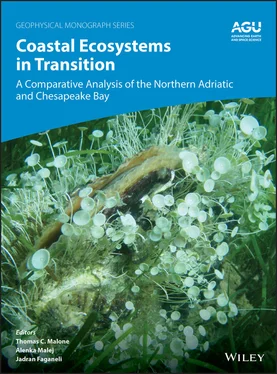For the NAS, efforts were made by Italian regulators to progressively reduce P content in detergents to 1% (6% for automatic laundry detergents) in 1989 (Marchetti et al., 1989; Rinaldi, 2014). In that year, industries also substituted sodium‐triphosphate‐based detergents with zeolite A (Glennie et al., 2002). The control of N loads has been improved recently with the adoption of the European Nitrates Directive (91/676/EEC). However, the reduction of N loads was less effective compared to that of P loads, because N is largely contributed by nonpoint sources (Viaroli et al., 2010, 2018). The creation of designated Authorities for specific hydrographic basins and of Regional Environmental Protection Agencies in 1994 further supported a coordinated monitoring of continental waters in Italy. The main measures adopted to reduce eutrophication from river loads were (a) establishment of spill basins and manure wastes for crop and livestock farming, (b) implementation of good farming practices in vulnerable areas, and (c) implementation of the Urban Waste Water Treatment Directive (91/271/EEC) (Bortone, 2014).
The N and P inputs in the NAS are not limited to riverine inputs. Direct inputs to the NAS occur via groundwater discharge and treatment plants, but are poorly quantified. Groundwater aquifers, particularly in the NE Adriatic region, are very sensitive to external pollution due to their large draining capacity of surface waters and low self‐cleaning potential (The EU.WATER Project, 2010). For treatment plants, several underwater pipelines have been built since the 1980s, especially in the NE Adriatic region. Despite a gradual upgrade of treatment plants from secondary to tertiary treatment, wastewater loads continue to be an important source of nutrients in the NAS (Cozzi et al., 2014; Scroccaro et al., 2010; Sekulić et al., 2004; Volf et al., 2018).
2.5. MAJOR CHALLENGES
2.5.1. Legacy Sources
Many restoration efforts around the world have not yet achieved significant progress in reducing riverine loads of nutrient and sediment due to challenges such as legacy inputs, which accumulate and are stored in groundwater aquifers and sediments. Such effects have been documented for watersheds in North America (e.g., Chesapeake Bay, Mississippi River, and Lake Erie) and Europe (Basu et al., 2010; Jarvie et al., 2013; Sharpley et al., 2013; Van Meter et al., 2017; Van Meter et al., 2017, 2018; Vero et al., 2017). For CB, there is strong evidence for the importance of legacy sources. For example, riverine loads in the Susquehanna remained relatively constant in the past 30 years despite strong reductions in anthropogenic inputs to watersheds (Zhang, Ball, et al., 2016). Such patterns may reflect the effects of legacy sources (Basu et al., 2010; Thompson et al., 2011). Van Meter et al. (2017) reported that N dynamics in the Susquehanna are dominated by groundwater legacies, with 18% of the current annual N input to the river being at least 10 years old. Apparent ages of groundwater in the CB watershed can reach 20 years or more (Focazio et al., 1997) and base flow accounts for a major fraction of riverine N load at many CB sites (Bachman et al., 1998). For this region, the legacy stores are comprised primarily of groundwater for N (Bachman et al., 1998; Sanford & Pope, 2013), surface soils and river sediments for P (Ator et al., 2011; Sharpley et al., 2013), and stream corridors and reservoir beds for sediment (Gellis et al., 2008; Pizzuto et al., 2014; Walter & Merritts, 2008). These results suggest the importance of considering lag time between implementation of management actions and achievement of water‐quality improvement. For the NAS, budget estimates indicate the accumulation in river watersheds of inorganic and organic N and P from anthropogenic sources that still negatively affect the quality of freshwater systems (Giani et al., 2012; Viaroli et al., 2018; Volf et al., 2018) and river‐dominated coastal areas (Alvisi & Cozzi, 2016).
Climate change is another major challenge to ecosystem restoration (Charlton et al., 2018; Forber et al., 2018; Meier et al., 2018; Rankinen et al., 2016; Sinha et al., 2017). In general, climate change is expected to result in increased air and water temperature and an acceleration of the water cycle (Bloschl et al., 2017; Milly et al., 2005; Najjar et al., 2010; Rice & Jastram, 2014; Rice et al., 2017), which can alter the volume transport of freshwater and inputs of nutrients and sediments. For example, Sinha et al. (2017) estimated that climate‐change‐induced precipitation changes alone will substantially increase (19 ± 14%) riverine inputs of TN within the continental United States by the end of the century. In addition, the effects of climate change can differ among seasons. For CB, projected acceleration of the water cycle is expected to increase river runoff and associated inputs of nutrients and sediments during winter–spring and to decrease runoff during summer–fall (Wagena et al., 2018). Thus, management strategies for CB need to account for the impact of projected climate change on water quality. In this context, modeling and assessment is underway in the Chesapeake Bay Program partnership to evaluate the effects of climate change on nutrient export, efficacy of best management practices, and water quality in the estuary.
In contrast, climate‐driven changes in the water cycle in the NAS watershed may tend toward persistent periods of low runoff alternating with episodic events of high discharge. Climate change appears to be increasing the frequency of heavy precipitation events (Alcamo et al., 2007). This has yet to induce long‐term changes in the annual discharge of the Po River, which has greatly oscillated over the past three decades without showing clear trends (Cozzi & Giani, 2011). However, flow dynamics of Po River are characterized by a shift towards early spring peaks of runoff (Zampieri et al., 2015) and a decline in summer flows (Cozzi et al., 2019). At the same time, the other NAS rivers have shown a strong reduction in flow (Cozzi et al., 2012). It is important to note that reductions in river flow can result from both a greater anthropogenic use of continental waters as well as from climate‐driven changes. For example, annual runoff to Adriatic rivers of Slovenia were reduced (6%) in 1971–2000 due to increased evapotranspiration of the soils (11%), even in the presence of relatively constant precipitation (Frantar, 2007).
A major challenge that is unique to CB is the filling of the Conowingo Reservoir of the Susquehanna River which has neared its sediment storage capacity after 90 years of operation. As sediment accumulates in this reservoir, the cross‐sectional area available for flow, and the vertical depth from water surface to sediment bed, decreases, thereby increasing the average horizontal flow velocity. Consequently, sediment trapping by the reservoir decreases and sediment load to CB increases. Numerous studies have demonstrated the declining trapping performance of this reservoir in recent decades (Hirsch, 2012; Langland, 2015; Zhang et al., 2013; Zhang, Hirsch, et al., 2016). Moreover, Zhang, Hirsch, et al. (2016) reported that such decline in reservoir trapping has occurred under a wide range of flow conditions. These changes, if not addressed, can hinder the attainment of the Chesapeake Bay Total Maximum Daily Load goals because the reservoir was expected to continue trapping sediments and nutrients at historical rates for another 20–30 years when those goals were established in 2010. Thus, the Chesapeake Bay Program partnership has worked to incorporate recent scientific understanding in upgrading its watershed model to better capture the temporal changes in reservoir function (Linker, Batuik, et al., 2013; Shenk & Linker, 2013), which will be used to adjust the goals of nutrient and sediment reductions by each jurisdiction.
Читать дальше












